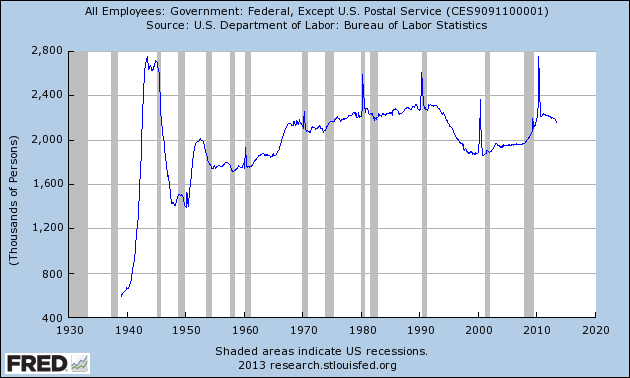 Politicians and economists can be accused of willfully obfuscating the “government employment trend” to serve their ideology. As an example, Republican Senator Rand Paul and liberal economist Paul Krugman engaged in a heated debate last Fall over whether government employment had increased or declined under the Obama administration. Rand Paul asserted that it had increased dramatically and Krugman countered that it had declined. They were both right. Krugman, defining government employment as including state and local government jobs, was technically correct–overall government employment had declined. Rand Paul, however, was speaking to federal employment and he too was correct because the federal portion of government employment had increased.
Politicians and economists can be accused of willfully obfuscating the “government employment trend” to serve their ideology. As an example, Republican Senator Rand Paul and liberal economist Paul Krugman engaged in a heated debate last Fall over whether government employment had increased or declined under the Obama administration. Rand Paul asserted that it had increased dramatically and Krugman countered that it had declined. They were both right. Krugman, defining government employment as including state and local government jobs, was technically correct–overall government employment had declined. Rand Paul, however, was speaking to federal employment and he too was correct because the federal portion of government employment had increased.
Let’s be clear: this article is about federal employment (civilian, non-Postal Service) and there is no doubt that it has grown since President Obama took office. In fact, from Obama’s January 2009 inauguration to the present, the number of federal jobs has always been greater than the level of federal employment at the end of the Bush presidency. During the first 26 months of the Obama administration the federal employment increased by a little more than 177,000 jobs. That pronounced surge was one factor that rallied the Republicans in Congress and spawned the Tea Party movement. It also buttressed the federal-leased real estate inventory, even in the wake of a withering recession.
More recently, however, federal employment is on the decline. The May employment data show that the civilian, non-Postal portion of federal government has decreased by 74,000 jobs from its peak in March 2011. This is a decline of 3.3%.
So, what does that suggest for the government property market? Well, to begin, federal employment trends have actually been a surprisingly poor indicator of federal demand for space, leased or owned (overall spending correlates much better). In fact, in the past four decades federal employment has changed very little while the federal (GSA) leased space inventory has grown 400%.
As further evidence of the employment/inventory disconnect, the Clinton Administration implemented its “National Partnership for Reinventing Government” initiative, which served to eliminate 400,000 federal jobs by the end of the Clinton presidency. Despite this, federal leased inventory growth increased through the Clinton presidency.
That said, the government’s current focus on tighter space utilization standards should begin to make employment a more relevant indicator going forward. If we simply look at the decline in employment relative to the size of the GSA’s leased inventory, it suggests that about 6.3 million SF of inventory demand has been lost since March 2011–even though actual GSA leased inventory increased by more than 6 million SF during the same period*. This growth, in the face of declining employment, belies a potential hollowing of the federal lease inventory.
* We use the GSA inventory as a proxy for the entire inventory of federal-leased real estate because most space–especially traditional office and industrial space–is leased through GSA. However, in the past many agencies used delegated contracting authority to lease space on their own. Delegation of leasing authority was substantially curtailed in late 2007 and, since then, those delegated leases have been renewed by GSA, thus growing GSA’s inventory even though there may be no actual net federal inventory growth.
